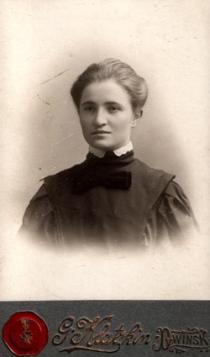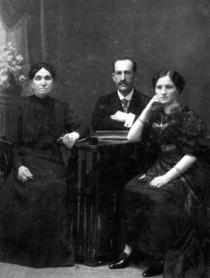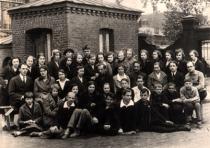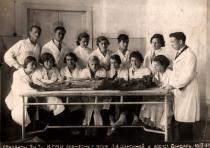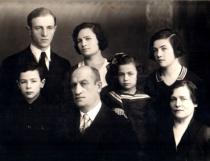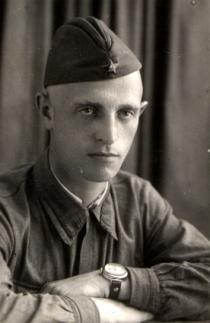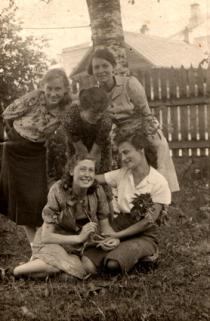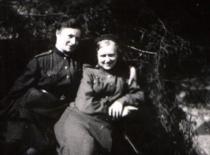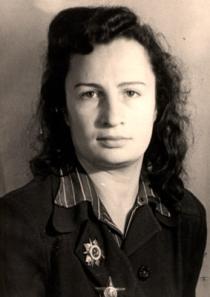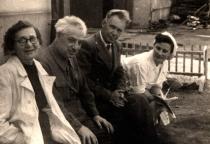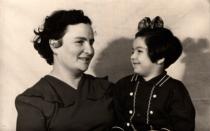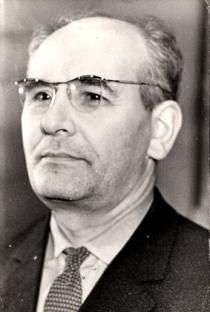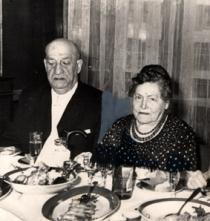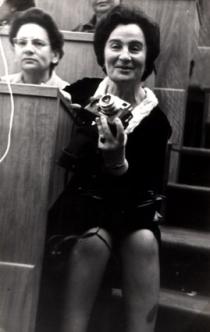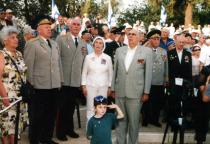This is I (to the left) with my colleague Tanya Lapshina, who worked with me in mobile field hospital #2407 of attack army #48. This is the year of 1943. The picture was taken in a forest out of Kursk during the break from the operations. I was acting chief of the department, in the rank of a captain of the medical service.
In October 1941 I and my brothers Evsey and Naum came to the military enlistment office and voluntarily joined the Soviet Army. I happened to be in Kuibyshev, where SES (Sanitary and Epidemiology Squad) #35 was formed. Each army had its own SES. Our squad was by 48th attack army and followed the army, sometimes even being ahead of the troops. Personnel and laboratories were in the emergency trucks covered with tarpaulin. I was sent to Elets to get the emergency vehicles. I was assigned the head of the column and was to get the vehicles to Bryansk front. It was November 1941. Sanitary and epidemiologic unit takes credit that there was no outbreak of epidemic for the entire period of war neither in the front lines nor in partisan squads. A lot of preventive measures were taken. SES work was dangerous and hard. We were caught in the fire and I had a light fragment wound in the knee-joint. The bone remained untouched. I was in the hospital.
When it was time for me to be discharged from the hospital they suggested that I should stay there for medical service as an attending physician of field mobile hospital of attack army #48. My military service was over in this hospital and my career was ended at the rank of acting head of the department. Being in the ranks of that army I went to Bryansk, Central, 1st attack army and Far East fronts. It was on the leading edge. Our hospital was called 'first line' hospital. It meant that we were in the immediate vicinity of the front line. The wounded were taken to us straight from the trenches. Moreover, we did not stay in one place longer than for 2-3 days. The hospital moved on trucks, sleighs and carts. Good thing if we managed to settle in any houses, but usually we lived in the tents, 25 people in each. We also operated in the tents as well. We slept on the floor.
The hospital was receiving patients - round o'clock. I do not remember how many wounded we had per day on the average. All I know is that there were days when there were hundreds of wounded. The medical personnel had to sleep for 2-3 hours per day. There were only 8 doctors and the rest were nurses. Wounded were carried by the nurses and orderlies (out of those who were recovering). In the event when there were a lot of wounded after the battle, everybody, including all doctors, took the stretches and carried the wounded. We were supposed to assist the wounded. Severely wounded were sent in the rear and those who had lighter wounds were operated on the table, treated for a while before going back to the lines.
Out of 8 surgeons only two of them had practice in operations and the six, who were to become therapists, neurologists or oculists. I was specialized in pediatrics. The six girls had spent hours by the operating table. Every day there were lectures in field surgery and simultaneous exams. The lectures were held by the chief physician of the hospital Alexander Pavlov and his deputy, the leading surgeon Peter Illionov right in the middle of the operation, in the tent imbued in blood, passing from one operating table. We performed a load of work - over 73% of the wounded were put in the lines. We did not accept 'I cannot', 'I do not know how', we only knew 'I must'. We had been working hard round o'clock. My main job was to amputate arms and legs. It was hard to conduct such operation for young people both from the moral and physical standpoint. I was supposed to hold on heavy amputated part. I also operated on light abdominal wounds and lungs.

